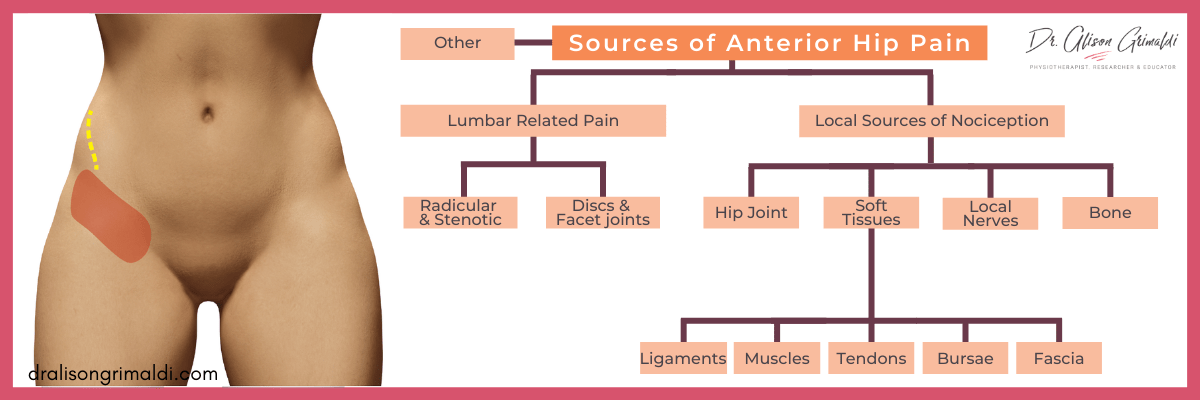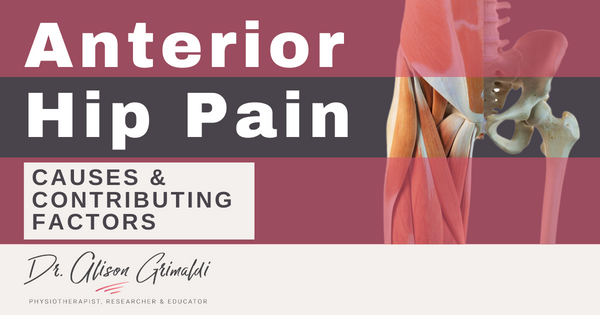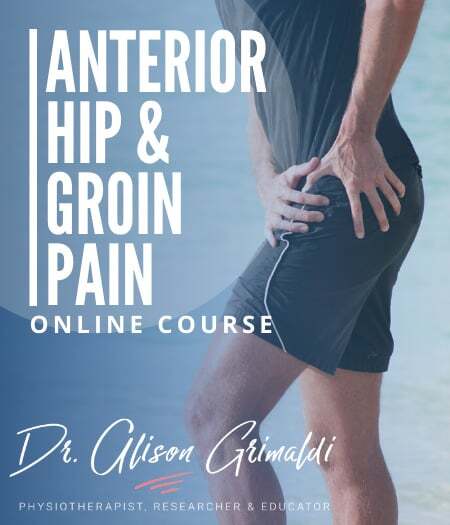Differential Diagnosis of Anterior Hip Pain – Joint

Anterior hip pain, or pain at the front of the hip, is one of the most common presentations of hip pain that we see in clinical practice. We are talking about the area directly anterior to the head of the femur , midway along the inguinal crease and extending laterally to the anterior superior iliac spine. For a relatively small area, there is a lot going on here!
- A number of muscles transit through or anchor in this region via their respective tendons, wrapped in fascial sleeves and cushioned directly anteriorly by the large iliopsoas bursa.
- The underlying joint is abundant in sources of nociception in it's labrum, capsule and ligaments, synovium and fat pads.
- Bones and growth plates in the area may become sources of nociception in various different circumstances.
- Local nerves may become impinged or damaged in trauma or surgical procedures.
- And it's always important to be aware of other referred and less common mechanisms for the presentation of anterior hip pain.

The flowchart above outlines the primary musculoskeletal sources of anterior hip pain and a framework for differential diagnosis of anterior hip pain. It is also possible for a patient to have multiple sources of nociception, often associated with similar mechanisms of overload or local or systemic inflammatory processes. Older individuals and those with long standing pain states commonly present with multiple sources of nociception or more complex pain mechanisms. A differential diagnosis is a great place to start in a clinical reasoning process, followed by an evaluation of potential mechanisms and impairments that inform individualised management strategies. Over the next few blogs, I'll be exploring common sources of nociception and associated conditions underlying anterior hip pain. This blog will be focusing on joint related anterior hip pain.

Joint Related Anterior Hip Pain
Hip joint related pain should be one of the top contenders in your differential diagnosis of anterior hip pain, particularly when the pain is experienced in the mid-inguinal region, directly anterior to the head of the femur, or if the patient grasps around their anterolateral hip with their webspace - the 'c-sign.' Risk factors for joint related anterior hip pain include overload or pathology of specific structures and certain morphological variations.
Pathologies and sources of nociception associated with joint related anterior hip pain:
- Chondrolabral pathology or labral tear
- Capsule or ligament strain or overload
- Iliofemoral ligament - Y Ligament of Bigelow
- Pubofemoral ligament
- Ligamentum teres tear
- Effusion synovitis - inflammation of the synovium and related effusion
- Fat pad inflammation
- Subchondral bone - bone marrow oedema, subchondral cysts/geodes and sclerosis
You can read more about the relevance of intraarticular pathology to pain and joint health in a previous 2-part blog: Part 1 - Labral, chondral and bone changes and Part 2 - Effusion synovitis and ligamentum teres tear.
Morphological variations associated with joint related anterior hip pain:
- Femoroacetabular Impingement Syndrome (FAIS) linked with
- cam morphology
- pincer morphology (although links with pain and pathology are not strong)
- mixed morphology
- Acetabular dysplasia resulting in reduced joint stability and/or weightbearing area
- global undercoverage of the femoral head by the acetabulum
- anterior undercoverage of the femoral head associated with excessive acetabular anteversion
- Femoral malversion
- excessive femoral anteversion - at risk of anterior overload and instability, particularly if associated with acetabular dysplasia and/or hypermobility
- femoral retroversion - at risk of anterior impingement
- Reduced hip joint stability associated with capsular laxity
- global laxity associated with some form of collagen disorder (Hypermobile Spectrum Disorder or hypermobile Ehlers Danlos Syndrome)
- focal laxity or insufficiency associated with trauma, focal overload or iatrogenic damage.

Features of hip joint related anterior hip pain
- Area of pain1:
- Mid-inguinal pain - half way along the inguinal crease, below the inguinal ligament - directly anterior to the hip joint. This pain is usually described as a deep ache with or without an intermittent sharp catch, usually with movement
- 'C' sign - where the patient grasps their anterolateral hip with their webspace in a 'c' shape
- 'Triangulation sign' - where the patient indicates a point somewhere deep in the middle of the mid-inguinal, mid-buttock and lateral hip regions
- +/or may present with referred pain to the anterior knee and anterolateral leg
- Night ache is common and usually indicates an inflammatory state
- Associated Symptoms:
- Restricted hip joint range of motion
- Historical restriction of range of motion related to femoroacetabular impingement or femoral malversion
- Gradually increasing loss of range related to hip osteoarthritis - commonly note difficulties with reaching the foot of the painful side when putting on shoes and socks2
- Limited by pain, muscle guarding or apprehension associated with instability
- Antalgic limp, particularly with more painful or advanced conditions
- Clicking and/or catching - may be related to joint pathology or joint laxity
- Reduced anterior stability may be reflected in reports of giving way, and lack of stability or confidence when weightbearing in extension +/- external rotation
- Restricted hip joint range of motion
- Aggravating Factors:
- Deep flexion - squatting and sitting or driving - worse with deep chairs and squatting but those with FAI may be less tolerant due to bony impingement earlier in joint range
- Pain on rising to stand and walk - with hip OA this is accompanied by stiffness that eases with movement
- Pain on weightbearing tasks and usually worse in more extended joint positions such as during end stance phase of gait, or secondary to impact loading of running or jumping
- Pain on weightbearing rotation - getting in/out of the car (stance leg) or planting the foot and changing direction during running or even twisting when moving around the kitchen or using a trolley at the shopping centre
- Pain lifting the leg in/out of car and in/out of bed
- Easing Factors:
- Eased by reducing hip loads into end range flexion, extension, rotation/circumduction and impact loading
- History of Onset
- May be associated with a single acute trauma involving overload of the anterior hip - hip flexion-internal rotation or extension-external rotation forces or large or unexpected impact through the foot or knee
- More often symptoms are of gradual onset or associated with an increase in volume or intensity of activity
- Patient Characteristics
- Hip osteoarthritis (OA) is most common in older age groups but may occur in younger people with significant bony risk factors, previous trauma +/- family history of OA
- Cam FAI is more common in males, particularly athletes who have had higher levels of exposure to change of direction sports3
- Pincer FAI appears to be similarly prevalent in males and females and links with pain and joint pathology have not been well established3
- Acetabular dysplasia is more common in females with other risk factors including being the firstborn child, having other family members with dysplasia and having being breech in utero4
- Reduced anterior stability - increased risk in those with known acetabular dysplasia, collagen disorders (hypermobility), or focal overload that may occur with excessive stretching or repetitive loading of the anterior hip capsule - dance, gymnastics, yoga, pitching.
KEY IDENTIFIERS OF HIP JOINT RELATED ANTERIOR HIP PAIN
Anterior hip pain is more likely to be related to the hip joint if:
- the pain is deep and mid-inguinal or anterolateral (c-sign pain)
- there is accompanying range restriction – either historical (FAI or femoral malversion), of gradual onset (OA) or related to pain or muscle guarding at end of joint range
- anterior hip pain is aggravated by deep hip flexion and/or repeated hip extension (e.g. walking fast or on a treadmill), or impact loads.
Download your FREE 12-page Book
Easily recognise the potential source of nociception or referral within the differential diagnosis of Anterior Hip Pain, with this Free eBook.
In this blog we've covered characteristic patient presentation features of hip joint related anterior hip pain - a key differential in the differential diagnosis of anterior hip pain. But there are many other important potential sources of nociception - bone, soft tissues and peripheral nerves, as well as additional systemic and nociplastic considerations. Next blog we'll be focusing on bone-related anterior hip pain, and patient demographics and characteristics that might make you suspect bone injury/pathology - sign up to the newsletter at the bottom of this page if you want to make sure you don't miss the remaining information.
Are you after more detail about anterior hip pain conditions, their pathoaetiology, assessment and management? You'll find plenty of evidence-based information and clinical pearls in my Anterior Hip & Groin Pain course. Or join the video library for access to a growing techniques library of clinical tests and exercises.
Another great Anterior Hip Pain blog

Anterior Hip Pain: Causes & Contributing Factors
Adequate consideration of individual causes and contributing factors is important for best outcomes.
Sign up to our newsletter to receive updates on upcoming courses, news and special offers.
References
- Lesher, J., Dreyfuss, P., Hager, N., Kaplan, M. and Furman, M., 2008. Hip Joint Pain Referral Patterns: A Descriptive Study. Pain Medicine, 9(1), pp.22-25.
- Rainville, J., Bono, J., Laxer, E., Kim, D., Lavelle, J., Indahl, A., Borenstein, D., Haig, A. and Katz, J., 2019. Comparison of the history and physical examination for hip osteoarthritis and lumbar spinal stenosis. The Spine Journal, 19(6), pp.1009-1018.
- van Klij, P., Heerey, J., Waarsing, J. and Agricola, R., 2018. The Prevalence of Cam and Pincer Morphology and Its Association With Development of Hip Osteoarthritis. Journal of Orthopaedic & Sports Physical Therapy, 48(4), pp.230-238.
- Yang, S., Zusman, N., Lieberman, E. and Goldstein, R., 2018. Developmental Dysplasia of the Hip. Pediatrics, 143(1), p.e20181147.




